 Cromarty Vortex | sitemap | log in Cromarty Vortex | sitemap | log in
|
 |
||
| This is a free Spanglefish 1 website. | ||
Astronomy BargainsMy top n astronomy best-buys (where n is a variable whole number yet to be decided)! Things that are utter bargains, un-do-withoutable. Best bang for buck. In no particular order...
8" Dobsonian
They are also endlessly tweakable and customisable. Mine (pictured above) started off as a ubiquitous grey-tubed GSO-680, but is now finished in metallic Peugeot Blaze Yellow, has Orion Hi-Lux coatings, a Telrad finder and an Accufocus electric focuser. Dobsonians are completely immune to the effects of Electromagnetic Pulses, making them ideal telescopes for use in areas that may be affected by hi-tech conflicts. Unless you have an electric focuser, but it can be easily reverted to manual focusing by loosening two small grubb screws. My review of the GSO-680 and update
TeleVue Plossls
TeleVue make some of the finest astronomical eyepieces in the world. They are famous for their widefield Panoptic, Nagler, Radian and Ethos lines, but their Plossls are real top performers and excellent value for money too. They are very sharp, extremely well made, give clear bright images, and are not that expensive to buy new (about £65-£85). But second hand they fall into utter bargain territory. You can get most focal lengths for about £35 to £50 second hand, and my best buy so far has been a 10.5mm Plossl for £18! Mint condition too, of course, as astronomers tend to look after their kit! But as always, Caveat Emptor. My article on eyepiece design and purchasing.
Turn Left at Orion
They should give this book away free with every telescope sold anywhere ever in the world. Yes, I quite like it! Although aimed at users of 'small' telescopes this book is just as useful for owners of 8" SCT's and 12" Dobs. As well as giving excellent directions to find all the best celestial objects, it provides pictures of what the objects will look like at the eyepiece. Not full-colour Hubble-esque pictures, but real pencil sketches that show what you can realistically expect to see. An astronomy book that's down to Earth - a welcome paradox. Book shop price is about £20 for this hardback, but you can usually get it cheaper from Amazon or other online book-sellers. Published by Cambridge University Press, ISBN 0-521-78190-6.
Orion Accufocus
The Orion Accufocus is a cheap, simple electric focuser that will attache to a large number of rack and pinion focusers, and by means of an additional bracket, to many Crayford type focusers too. Designed to fit Orion USA's range of telescopes, it will easily fit onto Synta, GSO, Skywatcher and many other makes, including some produced by Orion UK. It is a simple ten minute job to attach the motor, and you then have the ability to fine tune the speed at which the focuser moves by turning the speed knob on the handset. Two buttons control focus in and focus out. The advantage of this type of focusing is that it removes the inevitable 'jiggle' caused when focusing by hand. You can now have smooth jiggle-free focusing even at high powers. I've fitted one to my 8" Dobsonian, and it really helps when teasing fine details out of planetary views at 230x or higher. Oh, and it only costs £46.
Collins Gem Guide to Stars
This book costs only 499 pennies, contains all the constellations of the night sky, has easy to use sky charts for identifying them, lists objects of interest within them and gives directions for finding them. In addition to all that, it has sections on the planets and Moon, space travel, telescopes and loads more. And it's small enough to fit in your hip pocket. Honestly, only 499 pennies. It's ridiculously cheap. It's so good I'm on my fourth copy, as I keep giving my ones away or lending them to people and not getting them back, or just misplacing them... It's a great book for an absolute beginner, because it lets you learn the sky a piece at a time. This book and a red torch (and maybe a pair of binoculars) will give you a good start in observational astronomy. Published by Collins; ISBN: 978-0-00-717858-2. Vixen GP Equatorial Mount
If you want a sturdy, reliable, well-made equatorial mount for a small or medium sized telescope, the Vixen GP (now known as the GP-2) mount is an ideal candidate. Build quality is superb and it will last a lifetime. The tracking accuracy of this mount is excellent, and it can be fitted with motors custom-made by Vixen, or more cheaply by Synta/Skywatcher. Mine has EQ4 motors by Synta and the tracking even at high power is great. The GP will take up to an 8" tube assembly no problem, and paired with a 4" apo or 6" Newt or Maksutov it's a joy to use. Mine is pictured here on its Berlebach ash tripod, but the GP-2 can be ordered with with an aluminium or wooden tripod if bought new. At £299 brand new, it's a steal, but it gets better - they go for peanuts on the second hand market! I got mine for about £200 on eBay years ago and it's something I won't be selling! I've seen them recently for £150... Skywatcher ED Refractors
Skywatcher's line of ED refractors have brought true apochromatic performance to the masses. 'Apo' refractors are better than 'achromatic' ones because they use special glass combinations that bring all the wavelengths of light passing through them to a common focal point, meaning none of the false colour that affects their achromatic counterparts when viewing bright objects. The Skywatcher ED's have been out for a few years, in 80mm, 100mm and 120mm sizes. The 80 and 100 are most popular and most affordable. Build quality is good, and they come with an adequate Crayford focuser. On my ED100 I found the focuser slipped, so I replaced it with a Baader rotatable unit. The standard Crayford on my ED80 is just fine though.
The 80 is an ideal grab'n'go scope, at f7.5 it can give wide fields and still zoom in for high power lunar and planetary views at over 200x magnification. The ED100 is f9, and does show a fair bit more detail, though it is a longer tube and a bit heavier. I have both because I use the ED80 as g'n'g on my SupaTrak mount, and the ED100 on my Vixen GP for more 'serious' observing. So, fancy a 80mm Apo for just over £200? Then you'll be impressed by the price cuts just introduced across the range... Review of ED100 and upgrading the focuser
Coronado Personal Solar Telescope (PST)
The PST is a 40mm f10 refractor with a tuning etalon and special filters built-in. The tuner allows the exact wavelength allowed through to be slightly tweaked. This can increase or decrease the visability of specific H-Alpha features to bring out detail in one or reveal another. For example, in one position filaments may stand out more, but a slight turn of the tuner may cause them to fade but bring out bright active regions more easily. The PST can be bought brand new for less than £400. It comes with a simple focuser and will accept 1.25" barrel eyepieces. A simple Alt-Az mount is favoured by a lot of users, like the AZ-3 mount with manual slow-motion controls. Better eyepieces than the supplied 20mm Kelner will yield better views, and many people use CCD's, digital cameras or webcams to capture H-alpha images of the Sun through the PST. Ok, you can only look at one single object with this telescope, but what an active and exciting object the Sun is when seen through it! Vixen LVW EyepiecesVixen's LVW range of wide-field eyepieces are the unsung heroes of The LVW's are a range of medium width wide-fields, giving apparent field of view of 65 degrees (Panoptics give 68') with a fixed eye relief of 20mm across the range (like the Pentax XW's). They are extremely comfortable to use, and have excellent light throughput and clarity. Best of all though, especially in the longer focal lengths, is the flatness of field. When I was considering something in the 20mm-ish focal length and was looking at Panoptic 22mm or Pentax XW 20mm, it was brought to my attention that the Vixen LVW 22mm would give a perfectly flat field - better than the competition. When I bought and tested it, I found this to be true. Much less curvature of field than my Pentax XL 14mm, and hardly any other aberations either. Some observers have reported a slight amount of false colour when viewing bright objects at the very edge of field. I have noted this but it is not very obvious anyway. I paid £200 for my LVW 22mm and considered it worth every penny. Now though, they are a bit cheaper. Consider them astronomy's best kept eyepiece secret... Skymax 127 Maksutov
The 127mm tube has a focal length of 1500mm, giving f11.81, which will yield medium to high powers with relatively long focal length eyepieces. This can make high power observing more comfortable. Also, the Skymax is very tolerant of cheapie eyepieces - you don't need to buy the best to put in this 'scope's 1.25" (very smooth) focuser! The Maksutov design is often thought of as being just for planetary and lunar observers, but it is not so. The optics have a very small obstruction caused by the reflective centre spot on the meniscus plate (corrector) at the front of the tube, which means the views are not deprived of contrast or light gathering power. This benifits planetary observers, yes, but the same sharp, contrasty optical set can also give superb views of open and globular clusters, nebulae and brighter galaxies! Did I mention double stars? Or the Moon? Don't get me started... (Rimae Hadley no problem under good seeing, and Rigel is an EASY split.) The downsides are that the Maksutov design limits the field of view, so It may require collimation, but only very occasionally. They hold collimation extremely well and many never need to be adjusted at all. Now for the best bit: You can get a complete package with the 127 on an alt-az mount with built-in tracking for less than £300, or the tube assembly alone for around the £200 mark. Or if you fancy a minty 2nd-hand one for about £150 then be aware that they do appear on the classifieds pages...but it won't be mine!
|   |
|
 | ||
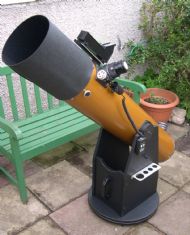
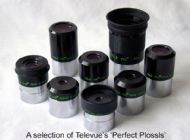
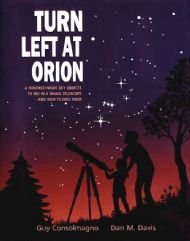
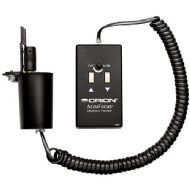
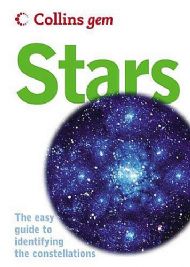
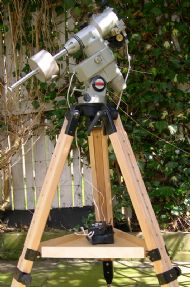

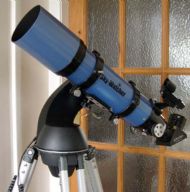 Note that originally the tube assemblies came out with blue tubes, and these were then updated to the "Pro" range with champagne coloured tubes and white trim. NB - the optics are exactly the same! The mechanicals are also exactly the same! The only thing that changed was the price, which went up, but essentially they are all the same telescopes. As you can see from the pic, my 80 is a standard model and the 100 a Pro.
Note that originally the tube assemblies came out with blue tubes, and these were then updated to the "Pro" range with champagne coloured tubes and white trim. NB - the optics are exactly the same! The mechanicals are also exactly the same! The only thing that changed was the price, which went up, but essentially they are all the same telescopes. As you can see from the pic, my 80 is a standard model and the 100 a Pro.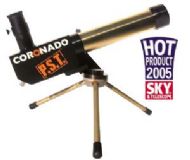 The Personal Solar Telescope (PST) comes in two flavours: Hydrogen Alpha and Calcium K. The H-Alpha version is the more mainstream one, and will allow the user to see dynamic features on the face and limb of the Sun that normal telescopes will not show. This is because the PST allows Hydrogen Alpha wavelengths through to the eyepiece but blocks most of everything else. The result is that you can see prominences (streamers or eruptions of gas leaping out from the limb), Filaments (prominences seen against the Sun's disc), Plages (patchy bright areas that show near active regions), and other features. These features will change even over the course of just a few hours, making the observation of the Sun in H-Alpha one of the most exciting and dynamic things in astronomy EVER!
The Personal Solar Telescope (PST) comes in two flavours: Hydrogen Alpha and Calcium K. The H-Alpha version is the more mainstream one, and will allow the user to see dynamic features on the face and limb of the Sun that normal telescopes will not show. This is because the PST allows Hydrogen Alpha wavelengths through to the eyepiece but blocks most of everything else. The result is that you can see prominences (streamers or eruptions of gas leaping out from the limb), Filaments (prominences seen against the Sun's disc), Plages (patchy bright areas that show near active regions), and other features. These features will change even over the course of just a few hours, making the observation of the Sun in H-Alpha one of the most exciting and dynamic things in astronomy EVER!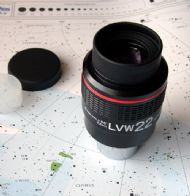 astronomical oculars. They are overshadowed, publicity-wise, by the competing TeleVue Panoptics, Baader Hyperions and Orion Expanses, but those in the know will never let their decision be influenced merely by marketing.
astronomical oculars. They are overshadowed, publicity-wise, by the competing TeleVue Panoptics, Baader Hyperions and Orion Expanses, but those in the know will never let their decision be influenced merely by marketing..jpg) Fancy big-scope aperture in a little-'scope package? Fancy robust and visually rewarding yet cheap? Then maybe the Skywatcher 127mm Skymax Maksutov is for you. The tube is just about a foot long yet has a respectable 5" (ish) aperture and yields excellent views. The Skywatcher Maks have been out for years and made waves when they were launched. Since day one the optics have been excellent. Not groundbreaking, but just very very good and ultra-affordable.
Fancy big-scope aperture in a little-'scope package? Fancy robust and visually rewarding yet cheap? Then maybe the Skywatcher 127mm Skymax Maksutov is for you. The tube is just about a foot long yet has a respectable 5" (ish) aperture and yields excellent views. The Skywatcher Maks have been out for years and made waves when they were launched. Since day one the optics have been excellent. Not groundbreaking, but just very very good and ultra-affordable.sm.jpg) you'll never get the whole of M45 or the Veil nebula into one field of view. Nor the M31 galaxy grouping, but there are many more objects that the 'scope will frame perfectly well. Also, you will need a dew shield with this tube, or the front corrector plate will soon be dewed up and you'll be heading home.
you'll never get the whole of M45 or the Veil nebula into one field of view. Nor the M31 galaxy grouping, but there are many more objects that the 'scope will frame perfectly well. Also, you will need a dew shield with this tube, or the front corrector plate will soon be dewed up and you'll be heading home.